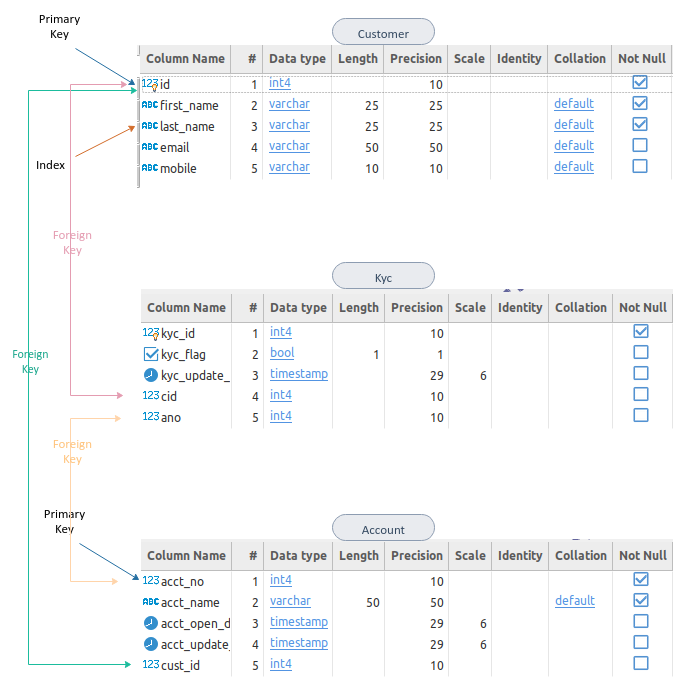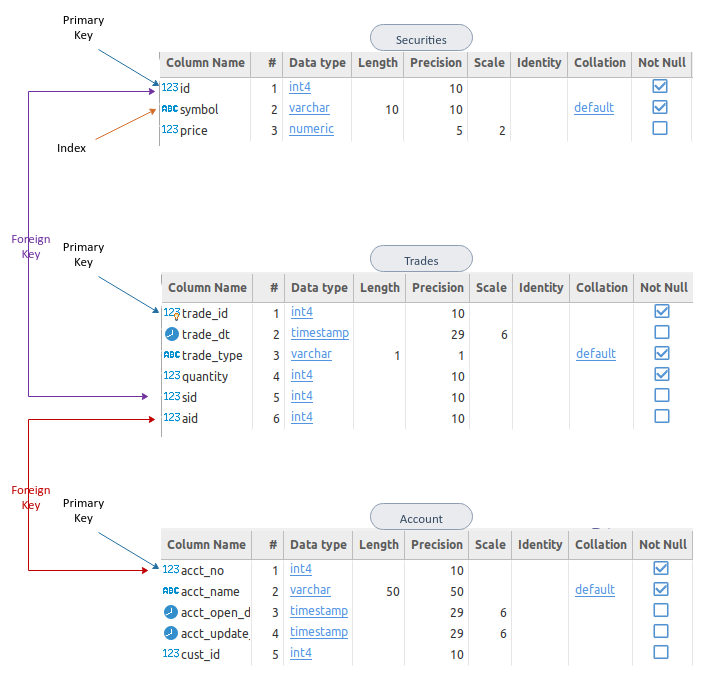Introduction to SQLAlchemy :: Part - 3
In Part - 2
of this series, we began exploring the basics of the the Object Relational Mapping (ORM)
layer for interacting with PostgreSQL database, as well as introduced the one-to-many
relationship between the customer and account entities.
In this article, we will explore the remaining two entity relationships - one-to-one
and many-to-many.
Hands-on with SQLAlchemy ORM Relationships
In Part - 1,
we created a simple database table called customer and in
Part - 2,
we created another simple database table called account with a one-to-many relationship
between them. In this demonstration, we will create yet another database table called kyc
with a one-to-one relationship with both the account and customer
tables. The following diagram illustrates this relationship:

Customer, Account, and Kyc
The class Kyc defined in the following Python program
(ex_sa_09.py) correspond to the database table kyc:
ex_sa_09.py
from datetime import datetime
from sqlalchemy import Column, ForeignKey, DateTime
from sqlalchemy import Integer, Boolean
from sqlalchemy.orm import relationship
from SQLAlchemy.ex_sa_05 import Base
class Kyc(Base):
__tablename__ = "kyc"
kyc_id = Column(Integer, autoincrement=True, primary_key=True)
kyc_flag = Column(Boolean, default=False)
kyc_update_dt = Column(DateTime(), default=datetime.now, onupdate=datetime.now)
cid = Column(Integer, ForeignKey('customer.id'))
ano = Column(Integer, ForeignKey('account.acct_no'))
customer = relationship("Customer", uselist=False)
account = relationship("Account", uselist=False)
def __repr__(self):
return "[Kyc: kyc_flag=%s, kyc_update_dt=%s, customer=%s, account=%s]" % \
(self.kyc_flag, self.kyc_update_dt, self.customer.last_name, self.account.acct_name)
The following are brief descriptions for some of the Python classes and methods:
In following Python program (ex_sa_10.py), the method
create_kyc_table creates the kyc database table and the
method insert_kyc_recs inserts *3* sample rows
for the associated account and customer:
ex_sa_10.py
import logging
from sqlalchemy.engine import Engine
from sqlalchemy.exc import SQLAlchemyError
from sqlalchemy.orm import sessionmaker
from SQLAlchemy.ex_sa_00 import create_db_engine
from SQLAlchemy.ex_sa_09 import Base, Kyc
logging.basicConfig(format='%(asctime)s - %(message)s', level=logging.INFO)
def create_kyc_table(engine: Engine) -> bool:
status = False
if not engine.dialect.has_table(engine, 'kyc'):
Base.metadata.create_all(db_engine)
logging.info("Created the kyc table !!!")
status = True
else:
logging.info("The kyc table already exists !!!")
return status
def insert_kyc_recs(engine: Engine):
if engine.dialect.has_table(engine, 'kyc'):
Session = sessionmaker(bind=engine)
session = Session()
try:
ad_kyc = Kyc(kyc_flag=True, cid=1, ano=1001)
session.add(ad_kyc)
session.commit()
logging.info("Inserted kyc for Alice")
except SQLAlchemyError as e:
logging.error(e)
try:
bb_kyc = Kyc(cid=2, ano=1002)
session.add(bb_kyc)
session.commit()
logging.info("Inserted kyc for Bob")
except SQLAlchemyError as e:
logging.error(e)
try:
cd_kyc = Kyc(cid=3, ano=1003)
session.add(cd_kyc)
session.commit()
logging.info("Inserted kyc for Charlie")
except SQLAlchemyError as e:
logging.error(e)
session.close()
else:
logging.info("The kyc table *DOES NOT* exist !!!")
if __name__ == "__main__":
db_engine = create_db_engine()
if create_kyc_table(db_engine):
insert_kyc_recs(db_engine)
To run the Python program ex_sa_10.py, execute the following command:
The following would be a typical output:
Output.1
2020-04-24 21:31:35,372 - Postgres database url: postgres://polarsparc:polarsparc$123@localhost:5432/my_test_db
2020-04-24 21:31:35,459 - Connected to the Postgres database !!!
2020-04-24 21:31:35,489 - Created the kyc table !!!
2020-04-24 21:31:35,506 - Inserted kyc for Alice
2020-04-24 21:31:35,509 - Inserted kyc for Bob
2020-04-24 21:31:35,511 - Inserted kyc for Charlie
The following Python program (ex_sa_11.py) demonstrates the
query and update operations on the kyc database table.
The method query_kyc queries all the records, the method
query_kyc_order queries all the records and sorts them in a descending order by the update date, and finally
the method update_kyc updates a row by the last name of the associated customer.
ex_sa_11.py
import logging
import time
from sqlalchemy.engine import Engine
from sqlalchemy.orm import sessionmaker
from SQLAlchemy.ex_sa_00 import create_db_engine
from SQLAlchemy.ex_sa_09 import Kyc
logging.basicConfig(format='%(asctime)s - %(message)s', level=logging.INFO)
def query_kyc(engine: Engine):
if engine.dialect.has_table(engine, 'customer') and engine.dialect.has_table(engine, 'account') and \
engine.dialect.has_table(engine, 'kyc'):
Session = sessionmaker(bind=engine)
session = Session()
recs = session.query(Kyc).all()
if len(recs) > 0:
for r in recs:
logging.info(r)
else:
logging.info("Record(s) for kyc *DOES NOT* exist !!!")
session.close()
else:
logging.info("The customer/account/kyc table(s) *DOES NOT* exist !!!")
def query_kyc_order(engine: Engine):
if engine.dialect.has_table(engine, 'customer') and engine.dialect.has_table(engine, 'account') and \
engine.dialect.has_table(engine, 'kyc'):
Session = sessionmaker(bind=engine)
session = Session()
recs = session.query(Kyc).order_by(Kyc.kyc_update_dt.desc())
if recs.count() > 0:
for r in recs:
logging.info(r)
else:
logging.info("Record(s) for kyc *DOES NOT* exist !!!")
session.close()
else:
logging.info("The customer/account/kyc table(s) *DOES NOT* exist !!!")
def update_kyc(engine: Engine, name: str, flag: bool):
if engine.dialect.has_table(engine, 'kyc'):
Session = sessionmaker(bind=engine)
session = Session()
rec = session.query(Kyc).filter(Kyc.customer.has(last_name=name)).first()
if rec:
rec.kyc_flag = flag
else:
logging.info("Record for Customer '%s' *DOES NOT* exist !!!" % name)
session.commit()
logging.info("Updated record for Customer '%s'" % name)
session.close()
else:
logging.info("The kyc table *DOES NOT* exist !!!")
if __name__ == "__main__":
db_engine = create_db_engine()
query_kyc(db_engine)
update_kyc(db_engine, 'Driver', True)
query_kyc(db_engine)
update_kyc(db_engine, 'Driver', False)
update_kyc(db_engine, 'Builder', True)
time.sleep(1)
update_kyc(db_engine, 'Builder', False)
query_kyc_order(db_engine)
The following are brief descriptions for some of the Python classes and methods:
-
Query.all() :: Method that selects all the rows from the specified database table
-
Query.order_by() :: Method that orders the selected rows in ascending order (by
default) on the specified column
-
desc() :: Method on a database column to indicate the default order needs to be
reversed (descending order)
-
has() :: Method that selects row(s) that match the specified criteria on the
specified database column
To run the Python program ex_sa_11.py, execute the following command:
The following would be a typical output:
Output.2
2020-04-24 21:36:16,810 - Postgres database url: postgres://polarsparc:polarsparc$123@localhost:5432/my_test_db
2020-04-24 21:36:16,866 - Connected to the Postgres database !!!
2020-04-24 21:36:16,879 - [Kyc: kyc_flag=True, kyc_update_dt=2020-04-24 20:11:35.501991, customer=Doctor, account=Alice Trade Account]
2020-04-24 21:36:16,883 - [Kyc: kyc_flag=False, kyc_update_dt=2020-04-24 20:11:35.507191, customer=Builder, account=Bob Credit Account]
2020-04-24 21:36:16,884 - [Kyc: kyc_flag=False, kyc_update_dt=2020-04-24 20:11:35.509393, customer=Driver, account=Charlie Trade Account]
2020-04-24 21:36:16,893 - Updated record for Customer 'Driver'
2020-04-24 21:36:16,897 - [Kyc: kyc_flag=True, kyc_update_dt=2020-04-24 20:11:35.501991, customer=Doctor, account=Alice Trade Account]
2020-04-24 21:36:16,898 - [Kyc: kyc_flag=False, kyc_update_dt=2020-04-24 20:11:35.507191, customer=Builder, account=Bob Credit Account]
2020-04-24 21:36:16,899 - [Kyc: kyc_flag=True, kyc_update_dt=2020-04-24 21:36:16.891167, customer=Driver, account=Charlie Trade Account]
2020-04-24 21:36:16,905 - Updated record for Customer 'Driver'
2020-04-24 21:36:16,910 - Updated record for Customer 'Builder'
2020-04-24 21:36:17,920 - Updated record for Customer 'Builder'
2020-04-24 21:36:17,929 - [Kyc: kyc_flag=False, kyc_update_dt=2020-04-24 21:36:17.917521, customer=Builder, account=Bob Credit Account]
2020-04-24 21:36:17,930 - [Kyc: kyc_flag=False, kyc_update_dt=2020-04-24 21:36:16.903741, customer=Driver, account=Charlie Trade Account]
2020-04-24 21:36:17,931 - [Kyc: kyc_flag=True, kyc_update_dt=2020-04-24 20:11:35.501991, customer=Doctor, account=Alice Trade Account]
In Part - 1,
we created a simple database table called securities. In this demonstration, we will
create another database table called trades with a many-to-many relationship with both
the account and securities tables. In other words, the database
table trades acts as a join table between the account and the
securities tables. The following diagram illustrates this relationship:

Account, Securities, and Trades
The classes Account, Securities, and
Trades defined in the following Python program (ex_sa_12.py)
correspond to the database tables account, securities, and
trades respectively:
ex_sa_12.py
from datetime import datetime
from sqlalchemy import Column, CheckConstraint, DateTime, ForeignKey, Numeric
from sqlalchemy import Integer, String
from sqlalchemy.orm import relationship
import SQLAlchemy
from SQLAlchemy.ex_sa_05 import Base
class Account(SQLAlchemy.ex_sa_05.Account):
security = relationship('Securities', secondary='trades')
class Securities(Base):
__tablename__ = "securities"
id = Column(Integer, autoincrement=True, primary_key=True)
symbol = Column(String(10), nullable=False, unique=True)
price = Column(Numeric(5, 2), default=0.0)
account = relationship(Account, secondary='trades')
def __repr__(self):
return "[Securities: id=%d, symbol=%s, price=%5.2f]" % (self.id, self.symbol, self.price)
class Trades(Base):
__tablename__ = "trades"
__table_args__ = (CheckConstraint("trade_type IN ('B', 'S')"),)
trade_id = Column(Integer, autoincrement=True, primary_key=True)
trade_dt = Column(DateTime(), default=datetime.now)
trade_type = Column(String(1), nullable=False)
quantity = Column(Integer, nullable=False, default=0)
sid = Column(Integer, ForeignKey('securities.id'))
aid = Column(Integer, ForeignKey('account.acct_no'))
account = relationship(Account, backref='trades')
security = relationship(Securities, backref='trades')
def __repr__(self):
return "[Trades: customer=%s %s, trade_dt=%s, trade_type=%s, quantity=%d, security=%s]" % \
(self.account.customer.first_name, self.account.customer.last_name, self.trade_dt, self.trade_type, \
self.quantity, self.security.symbol)
The following are brief descriptions for some of the Python keyword(s):
In following Python program (ex_sa_13.py), the method
create_trades_table creates the trades database table, the
method insert_trades inserts *6* sample trades, and the
method query_trades performs a query of the trades:
ex_sa_13.py
import logging
from sqlalchemy.engine import Engine
from sqlalchemy.exc import SQLAlchemyError
from sqlalchemy.orm import sessionmaker
from SQLAlchemy.ex_sa_00 import create_db_engine
from SQLAlchemy.ex_sa_05 import Customer
from SQLAlchemy.ex_sa_12 import Base, Account, Securities, Trades
logging.basicConfig(format='%(asctime)s - %(message)s', level=logging.INFO)
def create_trades_table(engine: Engine) -> bool:
status = False
if not engine.dialect.has_table(engine, 'trades'):
Base.metadata.create_all(db_engine)
logging.info("Created the trades table !!!")
status = True
else:
logging.info("The trades table already exists !!!")
return status
def insert_trades(engine: Engine):
if engine.dialect.has_table(engine, 'trades'):
Session = sessionmaker(bind=engine)
session = Session()
try:
t1 = Trades(trade_type='B', quantity=100, aid=1001, sid=1)
t2 = Trades(trade_type='B', quantity=300, aid=1001, sid=3)
t3 = Trades(trade_type='B', quantity=50, aid=1003, sid=1)
t4 = Trades(trade_type='B', quantity=150, aid=1003, sid=2)
t5 = Trades(trade_type='S', quantity=100, aid=1001, sid=3)
t6 = Trades(trade_type='S', quantity=50, aid=1003, sid=2)
tlst = [t1, t2, t3, t4, t5, t6]
session.add_all(tlst)
session.commit()
logging.info("Inserted record(s) for 6 trades:")
for tr in tlst:
logging.info("\t==> %s" % tr)
except SQLAlchemyError as e:
logging.error(e)
session.close()
else:
logging.info("The trades table *DOES NOT* exist !!!")
def query_trades(engine: Engine):
if engine.dialect.has_table(engine, 'account') and engine.dialect.has_table(engine, 'customer') and \
engine.dialect.has_table(engine, 'securities') and engine.dialect.has_table(engine, 'trades'):
Session = sessionmaker(bind=engine)
session = Session()
logging.info("SQL => %s" % session.query(Customer.first_name, Customer.last_name, Account.acct_name,
Trades.trade_dt, Trades.trade_type, Trades.quantity,
Securities.symbol, Securities.price) \
.select_from(Trades).join(Account).join(Securities).join(Customer))
recs = session.query(Customer.first_name, Customer.last_name, Account.acct_name,
Trades.trade_dt, Trades.trade_type, Trades.quantity,
Securities.symbol, Securities.price) \
.select_from(Trades).join(Account).join(Securities).join(Customer)
if recs.count() > 0:
logging.info("< -------------------------")
for r in recs:
logging.info(r)
logging.info("------------------------- >")
else:
logging.info("Record(s) for trades by customers *DOES NOT* exist !!!")
session.close()
else:
logging.info("The account/customer/securities/trades table(s) *DOES NOT* exist !!!")
if __name__ == "__main__":
db_engine = create_db_engine()
if create_trades_table(db_engine):
insert_trades(db_engine)
query_trades(db_engine)
The following are brief descriptions for some of the Python classes and methods:
-
add_all() :: Method that takes a list of domain model objects to add to the
Session for persistence
-
Query.join() :: Method to perform a join on the mapped domain model objects using
the foreign key relationships between them
-
Query.select_from() :: Method to control the 'left' side of the join
!!! ATTENTION !!!
Ensure the method select_from() is used to indicate the table on the left to perform the joins. Else will encounter the following error:
Can't determine which FROM clause to join from, there are multiple FROMS which can join to this entity. Please use the .select_from() method to establish an explicit left side, as well as providing an explcit ON clause if not present already to help resolve the ambiguity
To run the Python program ex_sa_13.py, execute the following command:
The following would be a typical output:
Output.3
2020-04-24 21:47:29,353 - Postgres database url: postgres://polarsparc:polarsparc$123@localhost:5432/my_test_db
2020-04-24 21:47:29,435 - Connected to the Postgres database !!!
2020-04-24 21:47:29,462 - Created the trades table !!!
2020-04-24 21:47:29,487 - Inserted record(s) for 6 trades:
2020-04-24 21:47:29,497 - ==> [Trades: customer=Alice Doctor, trade_dt=2020-04-24 21:47:29.478902, trade_type=B, quantity=100, security=BULL.ST]
2020-04-24 21:47:29,498 - ==> [Trades: customer=Alice Doctor, trade_dt=2020-04-24 21:47:29.482047, trade_type=B, quantity=300, security=BARK.ST]
2020-04-24 21:47:29,500 - ==> [Trades: customer=Charlie Driver, trade_dt=2020-04-24 21:47:29.482694, trade_type=B, quantity=50, security=BULL.ST]
2020-04-24 21:47:29,502 - ==> [Trades: customer=Charlie Driver, trade_dt=2020-04-24 21:47:29.483480, trade_type=B, quantity=150, security=DOG.ST]
2020-04-24 21:47:29,503 - ==> [Trades: customer=Alice Doctor, trade_dt=2020-04-24 21:47:29.484275, trade_type=S, quantity=100, security=BARK.ST]
2020-04-24 21:47:29,504 - ==> [Trades: customer=Charlie Driver, trade_dt=2020-04-24 21:47:29.485013, trade_type=S, quantity=50, security=DOG.ST]
2020-04-24 21:47:29,513 - SQL => SELECT customer.first_name AS customer_first_name, customer.last_name AS customer_last_name, account.acct_name AS account_acct_name, trades.trade_dt AS trades_trade_dt, trades.trade_type AS trades_trade_type, trades.quantity AS trades_quantity, securities.symbol AS securities_symbol, securities.price AS securities_price
FROM trades JOIN account ON account.acct_no = trades.aid JOIN securities ON securities.id = trades.sid JOIN customer ON customer.id = account.cust_id
2020-04-24 21:47:29,519 - < -------------------------
2020-04-24 21:47:29,520 - ('Alice', 'Doctor', 'Alice Trade Account', datetime.datetime(2020, 4, 25, 13, 47, 29, 478902), 'B', 100, 'BULL.ST', Decimal('25.75'))
2020-04-24 21:47:29,520 - ('Alice', 'Doctor', 'Alice Trade Account', datetime.datetime(2020, 4, 25, 13, 47, 29, 482047), 'B', 300, 'BARK.ST', Decimal('144.90'))
2020-04-24 21:47:29,520 - ('Charlie', 'Driver', 'Charlie Trade Account', datetime.datetime(2020, 4, 25, 13, 47, 29, 482694), 'B', 50, 'BULL.ST', Decimal('25.75'))
2020-04-24 21:47:29,520 - ('Charlie', 'Driver', 'Charlie Trade Account', datetime.datetime(2020, 4, 25, 13, 47, 29, 483480), 'B', 150, 'DOG.ST', Decimal('54.15'))
2020-04-24 21:47:29,521 - ('Alice', 'Doctor', 'Alice Trade Account', datetime.datetime(2020, 4, 25, 13, 47, 29, 484275), 'S', 100, 'BARK.ST', Decimal('144.90'))
2020-04-24 21:47:29,521 - ('Charlie', 'Driver', 'Charlie Trade Account', datetime.datetime(2020, 4, 25, 13, 47, 29, 485013), 'S', 50, 'DOG.ST', Decimal('54.15'))
2020-04-24 21:47:29,521 - ------------------------- >
This concludes the exploration of the basic capabilities in the SQLAlchemy ORM layer.

